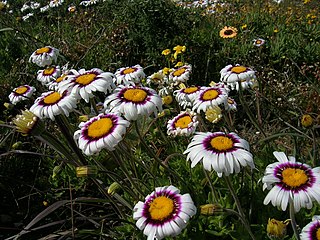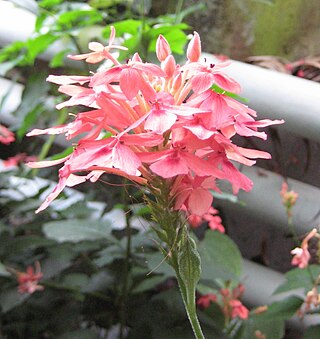
Pachypodium ambongense is a species of plant in the family Apocynaceae. It was first published as a species of the genus Pachypodium in 1924 by the botanist Henri Louis Poisson.

Pachypodium brevicaule is a species of plant that belongs to the family Apocynaceae.

Hovea linearis is a species of flowering plant in the family Fabaceae and is endemic to eastern Australia. It is an erect or trailing subshrub with mostly narrowly linear to linear leaves with stipules at the base, and mauve and yellowish-green, pea-like flowers.

Stemodia durantifolia is a species of flowering plant in the plantain family commonly known as the whitewoolly twintip and purple stemodia. Stemodia durantifolia is native to the Americas, including Chile, Mexico, Texas, and the deserts of California and Arizona, and is often found in riparian habitats, preferring wet sand and rocks. It is a perennial herb producing a hairy, glandular, erect stem 10–100 cm (3.9–39.4 in) tall, with the toothed lance-shaped leaves found in pairs or triplets, attached to the stem with clasping bases. The inflorescence is a raceme of violet flowers, with each corolla held in a calyx of hairy, pointed sepals, and can often be found in bloom year-round. Although globally at low risk of extinction, Stemodia durantifolia is imperiled in California due to its rarity and threats from development.
Acanthopale pubescens is a species of the genus Acanthopale of the family Acanthaceae. The species occurs in East and Southern Africa. Acanthopale pubescensis also known as Herayye in Ethiopia.

Brexia is a plant genus assigned to the Celastraceae. It is a dense evergreen shrub or small tree of usually around 5 m high, with alternately set, simple, leathery leaves with a short leaf stem and lanceolate to inverted egg-shaped leaf blades. The pentamerous flowers occur in cymes. The petals are greenish white, the stamens are alternating with wide, incised staminodes. The superior ovary develops in a long-ribbed fruit. Brexia naturally grows on the coast of East Africa, on Madagascar, the Comoros and Seychelles. Opinions differ about the number of species in Brexia. Sometimes the genus is regarded monotypic, B. madagascariensis being a species with a large variability, but other authors distinguish as many as twelve species. Common names for B. madagascariensis include jobiapototra, tsimiranjana, tsivavena, vahilava, voalava, voankatanana, voantalanina, voatalanina and votalanina, and mfukufuku (Swahili), mfurugudu and bwa kato (Seychelles).
Schizolaena elongata is a tree in the family Sarcolaenaceae. It is endemic to Madagascar.
Schizolaena cauliflora is a tree in the family Sarcolaenaceae. It is endemic to Madagascar. The specific epithet cauliflora means 'stem-flowered', referring to the flowers being directly attached to the stem.
Schizolaena exinvolucrata is a tree in the family Sarcolaenaceae. It is endemic to Madagascar.
Schizolaena manomboensis is a tree in the family Sarcolaenaceae. It is endemic to Madagascar. The specific epithet refers to Manombo Reserve where the species is found.
Eremolaena rotundifolia is a plant in the family Sarcolaenaceae. It is endemic to Madagascar. The specific epithet rotundifolia means 'round leaves'.

Cycnium tubulosum, also known as the vlei ink-flower and the tissue paper flower, is a slender hemiparasitic perennial plant of the broomrape family. Its range includes much of southern and eastern Africa, from South Africa to Ethiopia, including Madagascar. It has creeping, straggling or upright stems, with few narrow, entire leaves and erect, white or pinkish, slightly zygomorph flowers on a long tube, with five lobes, reminiscent of a Phlox-flower. It may not always be fully dependent on the supply of minerals by other plants, but usually makes connections with the roots of grasses. It can be found in moist, short grasslands, reaching altitudes of about 1,550 m (5,090 ft). Its conservation status in South-Africa is "least concern".

Felicia elongata is a perennial plant of up to 40 cm high that is assigned to the family Asteraceae. It has stiff, oval, opposing leaves with one distinctive vein and entire margin. The 5 cm (2 in) wide flower heads are very conspicuous in colour, white with a dark purple zone at the base of the ray florets and an orange-yellow disc. Flowering occurs from late August to September, or if the rains arrive late, sometimes October. It is a rare species that is restricted to the Saldanha Bay area. It is sometimes called Saldanha felicia or tricolour felicia in English, and driekleurblommetjie in Afrikaans.

Mini mum is a species of microhylid frog endemic to Madagascar that was described in 2019. It is the type species of its genus, Mini. The scientific name of the species refers to its size, being a pun on the word minimum: this wordplay led to the species receiving media attention when first described.

Otholobium saxosum is a small shrublet of up to 20 cm (7.9 in) high that has been assigned to the Pea family, with branches upright or horizontal at the base with rising tips. It has sessile, clover-like leaves and white, pea-like flowers that grow in triplets in the axils of the upper leaves of new, short side shoots. The species is only known from Garcia's Pass in Western Cape province of South Africa. Flowering occurs in October and November.
Goodenia rostrivalvis is a species of flowering plant in the family Goodeniaceae and is endemic to a restricted area of New South Wales. It is an ascending subshrub with egg-shaped to lance-shaped leaves with the narrower end towards the base, and thyrses or racemes of hairy yellow flowers.
Goodenia viridula is a species of flowering plant in the family Goodeniaceae and is endemic to a restricted area of Queensland. It is an erect undershrub with linear leaves and spikes of greenish-yellow flowers.
Hoffmannanthus is a monotypic genus of flowering plants in the Asteraceae. There is only one known species, Hoffmannanthus abbotianus(O.Hoffm.) H.Rob., S.C.Keeley & Skvarla Its native range is Uganda and southern Tropical Africa. It is found in the countries of Angola, Kenya, Tanzania, Uganda, Zambia and Zaïre.

Ruspolia is a genus of flowering plants belonging to the family Acanthaceae.
Stenostephanus brevistamineus is a species of flowering plant first collected 11 July 2013 in Junín, Peru. Stenostephanus is a genus in the plant family of Acanthaceae. The species holotype is housed at HOXA, with isotypes at MO and USM.










